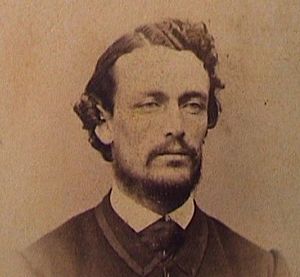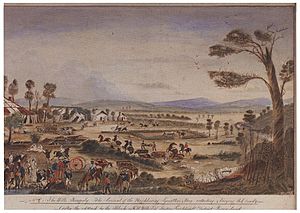Cullin-la-ringo massacre facts for kids
The Cullin-la-ringo massacre, also known as the Wills tragedy, was a very sad event that happened in Central Queensland, Australia, on 17 October 1861. It was a conflict between white settlers and Indigenous people. Nineteen people, including men, women, and children, were killed in the attack. This included Horatio Wills, who owned the Cullin-la-ringo station. It was the largest attack by Aboriginal people on settlers in Australian history. In the weeks that followed, police and other groups searched for those involved, and many members of the Gayiri Aboriginal tribe were killed in response.
Contents
The Attack at Cullin-la-ringo
In October 1861, a group of settlers from the colony of Victoria arrived in Queensland. They were led by Horatio Wills and planned to start a large sheep farm called Cullin-la-ringo. Their journey had been long, starting from Brisbane eight months earlier. They had a huge group, including many wagons and more than 10,000 sheep! This large group attracted a lot of attention from other settlers and also from the local Indigenous people.
It was later said that the attack happened because the Gayiri people wanted revenge. They believed that Horatio Wills' neighbour, Jesse Gregson, had wrongly accused them of stealing cattle and had killed some Gayiri men.
One of the people who survived, John Moore, later shared what he saw. On 17 October 1861, Aboriginal people had been passing through the camp all day. Their numbers grew until there were at least 50. Then, without any warning, they attacked the settlers. They used traditional weapons called nulla nullas. The settlers tried to defend themselves with pistols and tent poles. Sadly, 19 out of the 25 settlers were killed.
The people who died included Horatio Wills; David Baker, who was the overseer, along with his wife Catherine and their three children; a family named Mannion, including Mr. and Mrs. Mannion and their three young children; and several other men. In total, 19 lives were lost.
Who Survived?

Six people from the camp survived the attack. One of them was Tom Wills, Horatio's son. Tom Wills was a very well-known cricketer and helped create Australian rules football. The other survivors were James Baker, John Moore, William Albrey, Edward Kenny, and Patrick Mahony. These men were either not in the camp when the attack happened, or they managed to hide and avoid being seen.
It was Edward Kenny who rode to the nearest station, Rainworth Station, the next day to report the terrible event. John Moore was the only white person who saw the attack happen and lived to tell about it.
What Happened Next?
The Cullin-la-ringo massacre was a very important and tragic event in the frontier wars in Queensland. It was the largest attack by Aboriginal people on white settlers in Australia's history.
More About the Massacre
This event has been written about in books and stories.
- In 1893, Archibald Meston wrote a short story called "The Cave Diary." In this story, a character named Oscar Marrion thinks about getting revenge after someone he loves is killed in the Cullin-la-ringo massacre.
- The first serious study of the massacre was published in 1981 by Gordon Reid.
- The massacre is also a main part of Alex Miller's 2007 novel, Landscape of Farewell.
- It is also explored in books and plays about Tom Wills, like Martin Flanagan's 1996 novel The Call.
See Also
- Australian frontier wars
- List of massacres in Australia



